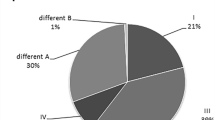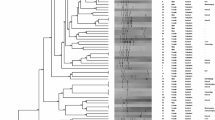Abstract
Escherichia coli is the main etiological agent of urinary tract infections. Its virulence factors are important during the initial interaction stage with the host as they enable colonization of urinary tract tissues. The genetic markers evidencing susceptibility to develop recurrent infections have been previously described. Toll-like receptors are critical sensors of microbial attacks, and they are also effectors of the individual’s innate defense for elimination of pathogens. The aim of this study was to evaluate the association between functional polymorphisms (896 A>G, 1196 C>T, − 2570 A>G, − 2081 G>A) and susceptibility to develop urinary tract infections as well as E. coli virulence factors. This study includes 100 samples from patients diagnosed with UTI and 100 samples from uninfected subjects. A conventional urine culture was performed and the isolates were identified by using the Vitek automated system. TLR4 gene polymorphisms were identified by the PCR–RFLP technique. The hlyA, fimH, papC, iutA and cnf1 virulence factors as well as the E. coli phylogenetic group were assessed by PCR. In this study, it was observed that the presence of the − 2570 polymorphism represents a risk of UTI (p < 0.01), whereas − 2081 confers protection (p < 0.01). The 896A>G and 1196C>T polymorphisms were associated with the E. coli virulence factors fimH and hlyA, respectively (p < 0.05). The B2 group was the most frequent in clinical isolates (51%), and it displayed more virulence factors regarding other phylogenetic groups (p ≤ 0.05). An interesting finding was that strains considered as commensals, belonging to groups A and B1, can cause UTI and present virulence factors. Polymorphisms occurring in the TLR4 promoter region are correlated with susceptibility or risk of UTI, whereas structural polymorphisms are associated with the recognition of virulence factors displayed by E. coli.


Similar content being viewed by others
References
Scholes D, Hooton TM, Roberts PL, Stapleton AE, Gupta K, Stamm WE. Risk factors for recurrent urinary tract infection in young women. J Infect Dis. 2000;182(4):1177–82.
Scholes D, Hooton TM, Roberts PL, Gupta K, Stapleton AE, Stamm WE. Risk factors associated with acute pyelonephritis in healthy women. Ann Intern Med. 2005;142(1):20–7.
Foxman B. Epidemiology of urinary tract infections: incidence, morbidity, and economic costs. Am J Med. 2002;113(Suppl 1A):5S–13S.
Spencer JD, Schwaderer AL, Becknell B, Watson J, Hains DS. The innate immune response during urinary tract infection and pyelonephritis. Pediatr Nephrol. 2014;29(7):1139–49.
Abraham SN, Miao Y. The nature of immune responses to urinary tract infections. Nat Rev Immunol. 2015;15(10):655–63.
Arbour NC, Lorenz E, Schutte BC, Zabner J, Kline JN, Jones M, et al. TLR4 mutations are associated with endotoxin hyporesponsiveness in humans. Nat Genet. 2000;25(2):187–91.
Bryant CE, Gay NJ, Heymans S, Sacre S, Schaefer L, Midwood KS. Advances in toll-like receptor biology: modes of activation by diverse stimuli. Crit Rev Biochem Mol Biol. 2015;50(5):359–79.
Behzadi P, Behzadi E, Ranjbar R. IL-12 family cytokines: general characteristics, pathogenic microorganisms, receptors, and signalling pathways. Acta Microbiol Immunol Hung. 2016;63(1):1–25.
Song J, Abraham SN. TLR-mediated immune responses in the urinary tract. Curr Opin Microbiol. 2008;11(1):66–73.
Jin MS, Lee JO. Structures of the toll-like receptor family and its ligand complexes. Immunity. 2008;29(2):182–91.
Frendeus B, Wachtler C, Hedlund M, Fischer H, Samuelsson P, Svensson M, et al. Escherichia coli P fimbriae utilize the toll-like receptor 4 pathway for cell activation. Mol Microbiol. 2001;40(1):37–51.
Fischer H, Yamamoto M, Akira S, Beutler B, Svanborg C. Mechanism of pathogen-specific TLR4 activation in the mucosa: fimbriae, recognition receptors and adaptor protein selection. Eur J Immunol. 2006;36(2):267–77.
Chakraborty DC, Mukherjee G, Banerjee P, Banerjee KK, Biswas T. Hemolysin induces toll-like receptor (TLR)-independent apoptosis and multiple TLR-associated parallel activation of macrophages. J Biol Chem. 2011;286(40):34542–51.
Medzhitov R. Toll-like receptors and innate immunity. Nat Rev Immunol. 2001;1(2):135–45.
Hagberg L, Hull R, Hull S, McGhee JR, Michalek SM, Svanborg Eden C. Difference in susceptibility to gram-negative urinary tract infection between C3H/HeJ and C3H/HeN mice. Infect Immun. 1984;46(3):839–44.
Ferwerda B, McCall MB, Verheijen K, Kullberg BJ, van der Ven AJ, Van der Meer JW, et al. Functional consequences of toll-like receptor 4 polymorphisms. Mol Med. 2008;14(5–6):346–52.
Rubi-Castellanos R, Martinez-Cortes G, Munoz-Valle JF, Gonzalez-Martin A, Cerda-Flores RM, Anaya-Palafox M, et al. Pre-Hispanic Mesoamerican demography approximates the present-day ancestry of Mestizos throughout the territory of Mexico. Am J Phys Anthropol. 2009;139(3):284–94.
de Cueto M. Microbiological diagnosis of urinary tract infections. Enferm Infecc Microbiol Clin. 2005;23(Suppl 4):9–14.
Miller SA, Dykes DD, Polesky HF. A simple salting out procedure for extracting DNA from human nucleated cells. Nucleic Acids Res. 1988;16(3):1215.
Ragnarsdottir B, Jonsson K, Urbano A, Gronberg-Hernandez J, Lutay N, Tammi M, et al. Toll-like receptor 4 promoter polymorphisms: common TLR4 variants may protect against severe urinary tract infection. PLoS ONE. 2010;5(5):e10734.
Lorenz E, Frees KL, Schwartz DA. Determination of the TLR4 genotype using allele-specific PCR. Biotechniques. 2001;31(1):22–4.
De Staercke C, Lally C, Austin H, Winston C, Dowling N, Williams B, et al. The lack of association between four point mutations in the promoter region of the toll-like 4 receptor gene and myocardial infarction. Thromb Res. 2007;119(1):105–10.
Scott VC, Haake DA, Churchill BM, Justice SS, Kim JH. Intracellular bacterial communities: a potential etiology for chronic lower urinary tract symptoms. Urology. 2015;86(3):425–31.
Godaly G, Ambite I, Svanborg C. Innate immunity and genetic determinants of urinary tract infection susceptibility. Curr Opin Infect Dis. 2015;28(1):88–96.
Mody L, Juthani-Mehta M. Urinary tract infections in older women: a clinical review. JAMA. 2014;311(8):844–54.
Minardi D, d’Anzeo G, Cantoro D, Conti A, Muzzonigro G. Urinary tract infections in women: etiology and treatment options. Int J Gen Med. 2011;4:333–43.
Hawn TR, Scholes D, Li SS, Wang H, Yang Y, Roberts PL, et al. Toll-like receptor polymorphisms and susceptibility to urinary tract infections in adult women. PLoS ONE. 2009;4(6):e5990.
Wiles TJ, Mulvey MA. The RTX pore-forming toxin alpha-hemolysin of uropathogenic Escherichia coli: progress and perspectives. Future Microbiol. 2013;8(1):73–84.
Pitout JD. Extraintestinal pathogenic Escherichia coli: a combination of virulence with antibiotic resistance. Front Microbiol. 2012;3:9.
Clermont O, Christenson JK, Denamur E, Gordon DM. The Clermont Escherichia coli phylo-typing method revisited: improvement of specificity and detection of new phylo-groups. Environ Microbiol Rep. 2013;5(1):58–65.
Millan Y, Hernandez E, Millan B, Araque M. Distribution of phylogenetic groups and virulence factors in CTX-M-15 beta-lactamase-producing uropathogenic Escherichia coli strains isolated from patients in the community of Merida, Venezuela. Rev Argent Microbiol. 2014;46(3):175–81.
Miranda-Estrada LI, Ruiz-Rosas M, Molina-Lopez J, Parra-Rojas I, Gonzalez-Villalobos E, Castro-Alarcon N. Relationship between virulence factors, resistance to antibiotics and phylogenetic groups of uropathogenic Escherichia coli in two locations in Mexico. Enferm Infecc Microbiol Clin. 2014;35:426–33.
Munkhdelger Y, Gunregjav N, Dorjpurev A, Juniichiro N, Sarantuya J. Detection of virulence genes, phylogenetic group and antibiotic resistance of uropathogenic Escherichia coli in Mongolia. J Infect Dev Ctries. 2017;11(1):51–7.
Luthje P, Brauner A. Virulence factors of uropathogenic E. coli and their interaction with the host. Adv Microb Physiol. 2014;65:337–72.
Behzadi E, Behzadi P. The role of toll-like receptors (TLRs) in urinary tract infections (UTIs). Cent Eur J Urol. 2016;69(4):404–10.
Acknowledgements
This work was supported by the Fondo FOMIX-CONACYT Gobierno del Estado de Guerrero Convocatoria M0008 2014-01 (No. 249671).
Author information
Authors and Affiliations
Corresponding author
Ethics declarations
Conflict of interest
The authors declare no conflicts of interest related to this study.
Ethical approval
This article does not contain any studies with human participants performed by any of the authors.
Informed consent
Informed consent was obtained from all individual participants included in the study.
Rights and permissions
About this article
Cite this article
Castro-Alarcón, N., Rodríguez-García, R., Ruíz-Rosas, M. et al. Association between TLR4 polymorphisms (896 A>G, 1196 C>T, − 2570 A>G, − 2081 G>A) and virulence factors in uropathogenic Escherichia coli. Clin Exp Med 19, 105–113 (2019). https://doi.org/10.1007/s10238-018-0527-0
Received:
Accepted:
Published:
Issue Date:
DOI: https://doi.org/10.1007/s10238-018-0527-0




